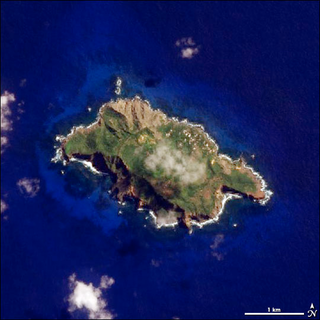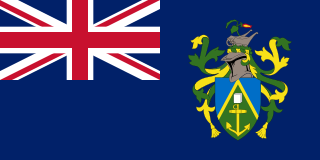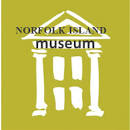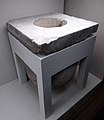
Norfolk Island is an external territory of Australia located in the Pacific Ocean between New Zealand and New Caledonia, 1,412 kilometres (877 mi) directly east of Australia's Evans Head and about 900 kilometres (560 mi) from Lord Howe Island. Together with the neighbouring Phillip Island and Nepean Island, the three islands collectively form the Territory of Norfolk Island. At the 2021 census, it had 2,188 inhabitants living on a total area of about 35 km2 (14 sq mi). Its capital is Kingston.

Pitcairn Island is the only inhabited island of the Pitcairn Islands, of which many inhabitants are descendants of mutineers of HMS Bounty.

The Pitcairn Islands, officially the Pitcairn, Henderson, Ducie and Oeno Islands, is a group of four volcanic islands in the southern Pacific Ocean that form the sole British Overseas Territory in the Pacific Ocean. The four islands—Pitcairn, Henderson, Ducie and Oeno—are scattered across several hundred miles of ocean and have a combined land area of about 18 square miles (47 km2). Henderson Island accounts for 86% of the land area, but only Pitcairn Island is inhabited. The islands nearest to the Pitcairn Islands are Mangareva at 688 km to the west and Easter Island at 1,929 km to the east.

The history of the Pitcairn Islands begins with the colonization of the islands by Polynesians in the 11th century. Polynesian people established a culture that flourished for four centuries and then vanished. They lived on Pitcairn and Henderson Islands, and on Mangareva Island 540 kilometres (340 mi) to the northwest, for about 400 years.

Fletcher Christian was an English sailor who led the mutiny on the Bounty in 1789, during which he seized command of the Royal Navy vessel HMS Bounty from Lieutenant William Bligh.
Pitkern, also known as Pitcairn-Norfolk or Pitcairnese, is a language spoken on Pitcairn and Norfolk islands. It is a mixture of English and Tahitian, and has been given many classifications by scholars, including cant, patois, and Atlantic Creole. Although spoken on Pacific Ocean islands, it has been described as an Atlantic Creole due to the lack of connections with other English-based creoles of the Pacific. There are fewer than 50 speakers on Pitcairn Island, a number which has been steadily decreasing since 1971.

HMS Pandora was a 24-gun Porcupine-class sixth-rate post ship of the Royal Navy launched in May 1779. The vessel is best known for its role in hunting down the Bounty mutineers in 1790, which remains one of the best-known stories in the history of seafaring. Pandora was partially successful by capturing 14 of the mutineers, but wrecked on the Great Barrier Reef on the return voyage in 1791. HMS Pandora is considered to be one of the most significant shipwrecks in the Southern Hemisphere.
Meralda Elva Junior Warren is an artist and poet of the Pitcairn Islands, a remote British Overseas Territory in the South Pacific. She works in both English and Pitkern, the island's distinctive creole language. Her book, Mi Bas Side Orn Pitcairn, written with the island's six children, is the first to be written and published in both English and Pitkern. As an artist, she works with tapa cloth, a Polynesian tradition. She has also published a cookbook featuring Pitcairn Island cuisine.
Bounty Day is a holiday on both Pitcairn Island, destination of the Bounty mutineers, and on Norfolk Island. It is celebrated on 23 January on Pitcairn, and on 8 June on Norfolk Island, the day that the descendants of the mutineers arrived on the island. It is named for the Bounty, although the ship never saw Norfolk Island.

Kingston is the administrative centre of the Australian external territory of Norfolk Island. The Norfolk Island Regional Council is based in Kingston. The settlement is the second-oldest in Australia, founded a little over a month after Sydney. It is part of the Kingston and Arthur's Vale Historic Area World Heritage Site.
Pitcairn Islanders, also referred to as Pitkerners and Pitcairnese, are the native inhabitants of the Pitcairn Islands, a British Overseas Territory including people whose families were previously inhabitants and maintaining cultural connections. Most Pitcairn Islanders are descendants of the Bounty mutineers.

Kingston and Arthurs Vale Historic Area (KAVHA) is an old settlement on the Kingston coastal plains, southern side of Norfolk Island, consisting of a large group of buildings from the British Empire's convict era (1788–1855), now considered to be of such cultural significance to Australia and to the World that the area has been formally inscribed onto both the Australian National Heritage List and UNESCO's World Heritage list as amongst:
" .. the best surviving examples of large-scale convict transportation and the colonial expansion of European powers through the presence and labour of convicts."

Cricket is recorded as having been played on Norfolk Island, an external territory of Australia, as early as 1838, by soldiers stationed on the island. It continued to be played after the island was settled in 1856 by Pitcairn Islanders, descended from the mutineers of the Bounty and of mixed European and Polynesian stock. John Patteson, an ex-first-class cricketer and future Bishop of Melanesia, was a missionary on Norfolk during that period. From 1876 until well into the 20th century, a match was played annually on Bounty Day, the national holiday, a tradition that was resumed in 1997. In 2001, it was reported that there were three clubs on the island, regular tours from the Australian mainland, and a junior development program, assisted by the New South Wales Cricket Association (NSWCA). Norfolk Island's cricket ground is located at Kingston Oval, which is the oldest cricket pitch in the Southern Hemisphere used since 1838, now with artificial matting overlooked by Kingston's convict-era buildings, which are World Heritage Sites.
Norfolk Islanders, also referred to as just Islanders, are the inhabitants or citizens of Norfolk Island, an external territory of Australia. The Islanders have their own unique identity and are predominantly people of Pitcairn and English descent and to a lesser extent of Scottish and Irish.

Norfolk Island is an external territory of Australia in the Pacific Ocean. It was settled in 1788 as with New South Wales and despite its small population and size it has developed its own traditions and legends, some slightly different from the mainland. The island was un-populated when settled, though evidence does suggest that it was home to a population of East Polynesians centuries earlier.

Teraura, also Susan or Susannah Young, was a Tahitian woman who settled on Pitcairn Island with the Bounty Mutineers. She took part in Ned Young's plot to murder male Polynesians who had travelled on HMS Bounty and killed Tetahiti. A tapa maker, examples of her craft are found in the British Museum and at Kew Gardens.

Mauatua, also Maimiti or Isabella Christian, also known as Mainmast, was a Tahitian tapa maker, who settled on Pitcairn Island with the Bounty mutineers. She married both Fletcher Christian and Ned Young, and had children with both men. Fine white tapa, which was her specialty, is held in the collections of the British Museum and the Pitt Rivers Museum, amongst others.
Bounty Museum, also Bounty Folk Museum, is the original museum on Norfolk Island, an Australian external territory in the Pacific.


















